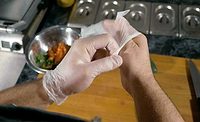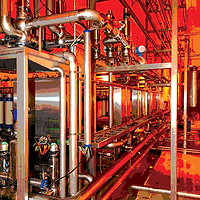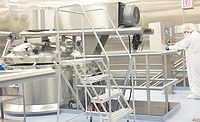The Importance of Cleaning for Food Safety

In food safety, cleaning and sanitation become a single concept, a single thought process. It is easy to lose sight of the function of cleaning as distinguished from disinfection. Without appropriate cleaning, effective disinfection can be difficult or impossible to achieve. Cleaning hard surfaces associated with food processing is becoming increasingly challenging. It is instructive to focus on the role of cleaning hard surfaces as a distinct activity. While this discussion emphasizes the cleaning of food contact surfaces and transfer lines, the principles also apply to noncontact surfaces.
Understanding Soil
Soil is matter out of place. Soil can be alive, dead, biological based, or nonbiological. Soil may be organic (carbon based) or mineral based with no carbon. Soils may be introduced inadvertently through air or mists, or people can introduce soils. A soil may have been an essential part of the process that, if it remains on the surface, becomes a liability.
Many soils are associated with food processing. Common organic soils include carbohydrates, proteins, fats, and petroleum. Soils can come from lubricants and greases used in food processing equipment. Metalworking fluids and lubricants can be petroleum based or bio based, and/or may be complex, proprietary mixtures of organic and inorganic material. Inorganic soils in food processing include salts, water stone (calcium nitrate), food stone (e.g., calcium oxalate), and metallic deposits like rust and oxides from processing equipment. Timmerman[1] describes many soils commonly found in food processing. Residues of cleaning/disinfecting agents are also soils. A comprehensive list of soils depends on the specific situation. It is therefore appropriate to consider the food processing application and determine all potential soils and residue that might impact the food.
Critical Cleaning
Cleaning is physically removing soils, not killing or inactivating or denaturing soils. Appropriate cleaning is required to manufacture medical devices and computer hardware. Cleaning product contact surfaces is essential in pharmaceuticals and paints.
Effective food processing requires critical cleaning. Critical cleaning is not necessarily more cleaning. Too much cleaning is costly in terms of supplies and labor; after a certain point, the cleaning process can damage product-contact surfaces. Manufacturers sometimes refer to precision cleaning as an ultimate goal. Precision cleaning involves setting up a strict written protocol and then never deviating from it. While a cleaning protocol is important, it is not a complete solution. The protocol must be effective. It is not unknown for cleaning to be performed the same way over and over, yet that cleaning is determined to be incorrect or ineffective.
Critical cleaning is value added. It is cleaning that, if eliminated, unacceptably raises the risk of harming the product. A critical cleaning process involves using a scientifically based, defendable protocol at the correct point(s).
Cleaning Is a Process
Effective disinfection starts with cleaning. Cleaning is a process, not just pouring a chemical onto a surface, wiping it around, and declaring that the surface has been cleaned, disinfected, and sanitized. There are three steps in a complete cleaning process. The first is washing. The function of the wash step is to ensure that the cleaning agent makes contact with the soil on the surface, to remove soil from the surface and keep it away from the surface. The next step is rinsing. Thorough rinsing is essential to remove the cleaning agent; it may also continue the cleaning action. Drying, the third step, removes water and volatile residue.
TACTful Cleaning
Cleaning processes involve TACT: temperature, action, chemistry, and time. In general, higher temperatures promote cleaning effectiveness. For every 10 °C increase in temperature, the reaction rate doubles. Action is the physical force that promotes soil removal. Two examples of action are high-pressure spray and elbow grease. Cramer[2] describes the function of the chemical components of cleaning agents. Terms like emulsification, saponification, peptizing agents, and dispersive agents translate to a host of chemical ingredients, not all of which are listed on the safety data sheet. The correct time is required at the wash, rinse, and dry stages. The temptation to decrease cleaning process time is pervasive through many industries. For this reason, cleaning processes have to be not only clearly defined but also documented and monitored.
More is not necessarily better. Cleaners should be used at recommended dilutions. There have been instances where employees have poured cleaning concentrate directly onto surfaces. Some cleaners can be more effective at removing soils when they are diluted. Using excessive cleaner can make rinsing difficult. Those who formulate chemistries for cleaning and disinfection are put in a bit of a catch-22 situation. From an environmental and economic standpoint, concentrated products are a great idea. Shipping concentrate has a smaller environmental footprint; less packaging is needed and less water means lower cost per pound. However, if employees decide that more product means better performance, the concentrate may be wasted, and the process may be compromised.
Compatibility and Coordination
The cleaning process must not damage the work surface. It would be unacceptable for the cleaning process to increase surface porosity because soils could become entrapped and more difficult to remove. Materials compatibility issues are a potential problem with any cleaning process, because a process that effectively removes soil could interact with the surface. With repeated cleaning cycles, aggressive cleaners can damage food contact surfaces. Thus, regular inspection of such surfaces is crucial.
Cleaning must be coordinated with disinfection. Life requires water, the correct atmosphere, a favorable temperature, an appropriate amount of time, and a supply of the right food, at the correct acidity or alkalinity. Life is persistent and inventive. Therefore, cleaning and disinfecting should be designed and tested relative to the application.
Tackling Residue
Achieving critical cleaning in food processing also includes understanding what makes soils stick. Factors include temperature, physical forces, chemistry, and time—the same TACT factors that are involved in cleaning.
The residue to be removed is not always the same as the original soil. Altered soils are often much more difficult to remove than the original material. Temperature can chemically modify soil. For example, sugar is relatively simple to remove from a hard surface. However, adding heat to simple sugars produces caramel. Caramel consists of thousands of complex compounds[3] that are far more difficult to remove than sugar. Physical forces can also result in more adherent soils, in part by driving soils into hard surfaces and changing the nature of the soil. This can happen even with careful selection of food processing equipment. If soil, including food residue, is allowed to remain on surfaces, it becomes more difficult to remove. Time and exposure to air and moisture can change the soil. In explaining the importance of prompt cleaning to those involved in other industries, we often use the example of how much more difficult it is to clean a lasagna pan that has been left on the counter overnight. The time between processing and cleaning should be minimized.
Difficult Soils
Some soils are inherently more difficult to remove than others. Among more classic soils, Timmerman points out that, for example, carbohydrates tend to be more readily removed than denatured protein.[1]
Botanicals are often difficult soils to remove. As foods become more sophisticated, it is inevitable that we will see greater cleaning challenges in food processing. Materials like vitamin K can adhere to analytical equipment; if cleaning is difficult in the analytical world, it ought to raise a red flag in food processing. The Agriculture Improvement Act of 2018 removed hemp from Schedule 1 of the Controlled Substances Act of 1970 and implemented new provisions for hemp production.[4] Processing cannabis edibles involves removing soils that are very adherent to hard surfaces. Even if the material is removed promptly, more complex cleaning processes have to be developed. The surface may be successfully disinfected, but it may not be clean enough. Particularly with cannabis processing, the philosophy of cleaning needs to move more toward that used for pharmaceuticals and perhaps even into a specific category. Dedicated processing equipment is prudent. However, using dedicated equipment does not eliminate the need for carefully defined cleaning processes.
How Clean Is Clean Enough?
In food processing, a clean surface is often taken to mean “visibly clean.” What does “visibly clean” actually mean? It’s a subjective concept, and it is one that has been successful historically. For many applications, it may not be necessary to use complex analytical techniques to demonstrate clean. At the same time, it is appropriate to demonstrate, define, document, and illustrate visibly clean surfaces in the context of your food processing requirements. A picture is worth a thousand words. Demonstrations are better; hands-on exercises are better still. During employee training, it is reasonable not only to show cleaning techniques but also to illustrate what a clean surface ought to look like. Depending on the processing equipment, the process might call for required lighting to view the surface and areas of the equipment to be inspected. Cleaning process documents are easier to understand when they include photographs of a clean surface and one that is not clean.
Visual cleanliness of food contact equipment may not be sufficient, because some residue may have a clear or glass-like quality. UV light and/or ATP (adenosine triphosphate) may reveal previously hidden soils. Are all surfaces visible? Process equipment may require partial disassembly for cleaning. Documentation of the procedure for disassembly (and reassembly) and specific cleaning requirements, including process and frequency, must be specified. Cleaning protocols may have to be validated by appropriate cleanliness testing or surface testing methods that would not be practical to use on an ongoing basis. In such instances, a strategy such as periodic surface monitoring, using contact angle determination, may be appropriate.
How clean is clean enough? The rule in 21 C.F.R. Part 110 includes Good Manufacturing Practices.[5] The guidance is general, the bottom line is “clean enough.” This means as a manufacturer, you have to justify and demonstrate with defendable methods what is clean enough.
Cleaning difficult soils in food processing is not restricted to cannabis processing; the botanical example points to the importance of cleaning as distinguished from disinfection. Effective cleaning means that residue from one batch of food does not interfere functionally or aesthetically with subsequent batches. If residue from one batch impacts the appearance, texture, taste, or odor of subsequent batches, there can be adverse economic implications aside from safety factors, even if sanitation is achieved. Therefore, it is important to be on the lookout for interfering residue from all sources, including cleaning/disinfecting agents themselves.
Soil residue combined with subtle damage to process equipment impacts more than food aesthetics. Buildup of residue makes disinfection more difficult and could also support development of biofilms.[6] Biofilms are designed to survive, in part by creating their own protective armor. Although food processing facilities are designed to discourage development of biofilms, scrupulous attention to the cleaning process is essential.
Training and a Food Safety Culture
Consistent, effective cleaning is not likely to happen without effective employee training and without monitoring employee performance of the cleaning tasks. Training should include education and is most effective when it is a two-way street. One reason is that cleaning is in part cultural. Developing company values where food safety is an inherent part of corporate culture is essential.[7] We all probably learned how to clean from family and community practices. Some in industry assert that workers of a particular ethnic background are always going to clean improperly and that you can’t teach “them.” In our experience, most of us have the capacity to learn. Time invested in training programs that include not only the rules but also the reasons behind the rules is time very well spent. In fact, a team approach that includes feedback from employees about the required cleaning/sanitation processes can be an illuminating approach to food processing. That feedback can also improve process performance and save money. Getting feedback means making sure employees are actually telling you what’s going on, that you actually hear their suggestions, and that you listen. An unresponsive “command and control” approach often covers up cleaning problems. A collaborative approach solves problems.
The authors thank Patrick Murphy, Spec Test Services LLC, for his comments and suggestions.
Barbara Kanegsberg and Ed Kanegsberg, Ph.D., are industry leaders in critical and industrial product cleaning at BFK Solutions LLC.
References
1. Timmerman, HA. “Cleaning in the Food Processing Industry,” in Handbook for Critical Cleaning, Applications, Processes, and Controls, vol. 2, eds. Kanegsberg, B and E Kanegsberg (Boca Raton, FL: CRC Press, 2011), 271–282.
2. www.food-safety.com/magazine-archive1/februarymarch-2007/sanitation-best-practices/.
3. Golon, A and N Kuhnert. 2012. J Agric Food Chem 60(12):3266–3274.
4. www.ams.usda.gov/sites/default/files/HempExecSumandLegalOpinion.pdf.
5. Electronic Code of Federal Regulations, Title 21, Chapter 1, Subchapter B, Part 110. May 24, 2019.
6. Kanegsberg, B, et al. 2015. Controlled Environments Magazine May/June.
7. www.food-safety.com/magazine-archive1/aprilmay-2019/food-safety-culture-science-social-science-food-science/.
Looking for a reprint of this article?
From high-res PDFs to custom plaques, order your copy today!








